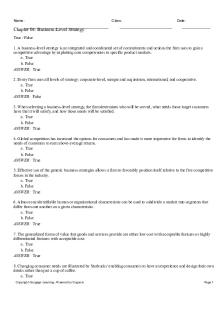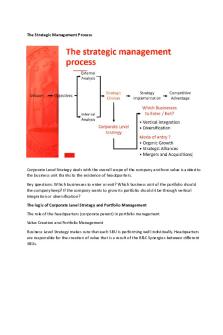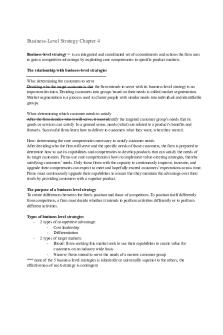Business Level strategy PDF

| Title | Business Level strategy |
|---|---|
| Course | Fundamentals of Strategic Management |
| Institution | Loughborough University |
| Pages | 14 |
| File Size | 612.4 KB |
| File Type | |
| Total Downloads | 364 |
| Total Views | 980 |
Summary
Business-level strategyThe purpose of a business-level strategy To create (meaningful) differences between the firm’s position in an industry and those of its competitors (i., competitive advantage). A choice either to perform differently or to perform different activities Using the value chain’s pr...
Description
Business-level strategy
The purpose of a business-level strategy • • •
To create (meaningful) differences between the firm’s position in an industry and those of its competitors (i.e., competitive advantage). A choice either to perform differently or to perform different activities Using the value chain’s primary and support activities to create unique value is one way to do this. A focus on products and services, their cost and features, and positional advantage is the main way. – Note, each business unit will have its own business strategy.
Business strategy route to achieving CA
Firms these can do both, especially if supported by an effective corporate strategy. CA is defined as the ability to create more economic value than competitors (Barney and Hesterly, 2006).
Types of business-level strategies 1. 2. 3. 4. 5.
Cost leadership Differentiation Focused cost leadership Focused differentiation Integrated cost leadership/differentiation
Each strategy helps the firm to establish and exploit a particular competitive advantage within a particular competitive scope.
• •
There is a BIG difference between your INTENDED positional advantage and your REALIZED positional advantage (Hughes et al., 2010). Your ability to realize advantage depends on strategic agility and capabilities. – Strategic sensitivity (e.g. environment scanning) – Resource fluidity (e.g. [dynamic] capabilities) – Leadership unity
1. Cost leadership strategy •
An integrated set of actions taken to produce goods or services with features acceptable to customers at the lowest cost, relative to that of competitors. • 5 Forces factors key: – Rivalry with existing competitors pushes cost down. You need to establish lower or lowest cost. – Negotiate hard with suppliers to secure discount and fast supply; pass supply costs back into the chain (e.g., just-in-time). – Use cost as barrier to entry – standardized products – features are acceptable to many customers – Competitive risks of the cost leadership strategy: how do you know you have the lowest cost base to sustain a low-price strategy? Examples might be RyanAir and Easyjet… Use the value chain to prioritise areas for cost management and GET RID of or ENHANCE activities you don’t need / need in-house. (But, be careful not to harm the capabilities needed for your strategy to succeed, and don’t neglect innovation…) e.g. VW, Ford team up to make autonomous, electric vehicles.” (Japan Today, July 2019)
Requirements of a cost leadership strategy
Building efficient scale facilities Tight controlling production costs and overhead Minimizing costs of sales, R&D and service Building state of the art manufacturing facilities Monitoring costs of activities provided by outsiders Simplifying production processes
CAPABILITIES needed for Cost Leadership.
Major Risks of Cost Leadership • • • •
Deleting elements of value chain that actually matter Dramatic technological change could open up cost reductions for rivals Low cost methods are POTENTIALLY EASILY IMITATED by rivals. Focus on efficiency could cause cost leaders to overlook changes in customer preferences
2. Differentiation strategy • •
•
An integrated set of actions to produce goods or services at an acceptable cost that customers perceive as different in ways that are important to them. 5 forces again important, by looking to create defendable position based on difference and barriers to entry: – Rivalry with existing competitors – Bargaining power of buyers (customers) – Bargaining power of suppliers – Potential entrants – Potential substitutes Competitive risks of the differentiation strategy: is the uniqueness, and its costly, valued and can it be imitated or substituted?
Differentiation: Key criteria • • • • • •
Value is provided by unique features of products Charge premium prices Exceptional customer service Superior quality Prestige or exclusivity Rapid innovation
Tangible and Intangible Differentiation •
•
Tangible differentiation – Observable features of a product and services – The performance of a product Intangible differentiation – Social, emotional and psychological considerations (i.e. status, exclusivity and individuality) e.g. Nike Jordan’s trainers
Requirements for creating sustainability of this position: • • •
Creating barriers by perceptions of uniqueness (so you need an effective functionallevel marketing strategy) Creating switching costs through differentiation (but you also need an effective functional-level innovation strategy to maintain that) Building brand loyalty (need marketing strategy again)
Capabilities needed • • • • • •
Strong marketing Pricing expertise Innovation Cooperative distribution Creative people Coordination of functions
Major Risks of Differentiation • • • •
Customers may feel that the cost of “uniqueness” is too high. Competitors may learn how to imitate the value chain. The means of uniqueness may no longer be valued by customers. Competitors might improve upon your differentiation, e.g., Ultraboost vs. Nike Air.
Explorative and exploitative product innovation, brand is essential to a differentiation strategy. Neither strategy is easy (cost leadership and differentiation), both relying on specific capabilities and requiring a careful consideration of critical success factors while mitigating critical danger factors.
3. Focus strategies • •
• •
• • •
•
An integrated set of actions taken to produce goods or services that serve the needs of a particular customer segment. Two types: 1. Focused cost leadership strategy 2. Focused differentiation strategy Competitive risks of focus strategies: You may reveal a highly profitable market opportunity that could be scaled with the right resources and size… Can be powerful for boutique type firms, e.g., see the premium watchmaking segment (e.g., Christopher Ward, London) and clothing segment (e.g., Off-White). A business concentrates on a narrowly defined market (niche market) A firm may lack resources to compete industry wide. A firm may be able to serve a narrow market segment more effectively than industrywide competitors (e.g. Iceland Focus-Cost) (e.g., which is not profitable enough for larger companies, for example). Large firms may overlook small niches.
Major risks from a focused differentiation business level strategy •
•
A large competitor may have waited for your business to ‘prove’ the market. Thus, focused companies may become takeover targets (just look at the tech sector – are you sure something really is just niche?). (Uber is being replicated left and right now, for example, but its market valuation is huge.) Preferences of a niche market may change to match those of a broad market (e.g. Ocado? Focus-Differentiated)
4. Integrated/hybrid cost leadership/differentiation strategy Slightly linking to ambidexterity as they’re challenged to do both simultaneously. • • • • •
Engaging in primary and support activities that allow a firm to simultaneously pursue low cost and differentiation Flexible manufacturing systems Information networks: Leverage capabilities through information networks across multiple business units. Use Total Quality Management systems to create high-quality differentiated products which simultaneously drive down costs. Competitive risks of the integrated cost leadership/differentiation strategy: getting ‘stuck in the middle’
Issue of being stick in the middle neither gaining a low share of a market at a high price nor gaining a large share of a market at a low price.
A new solution to hybrid strategies: Coopetition? Coopetition has been broadly defined as collaboration between competing firms or the simultaneous competition and collaboration between the same actors (Bengtsson & Kock, 2000). •
•
• •
Cooperative competition”: A situation win which rivals in an industry cooperate to enter new markets, segments, co-share R&D costs, share technology, or help establish a new segment or market, etc. Examples: – VW and Ford collaborating to share R&D costs for electric cars (putting in tens of billions, more than either could afford alone, and help fast-track tech development/catch up. – Samsung and Sony supply parts to Apple for iPhone. – Apple recently split for its relationship with Intel, despite that relationship being credited with helping to turnaround Apple’s fortunes in the early 2000s. – Look at Amazon and Amazon Marketplace – M&S and Ocado – Goes beyond value chain logic: This is at the business model level. Coopetition among Australian wine producers to increase the competitiveness of the continent in global competition (Choi et al., 2010) Collaboration in the global airline industry in the form of airline alliances that share costs related to marketing, logistics, and ticketing (Oum et al., 2004)
Internationalisation
We need to adjust our business strategy Consider how we’ll move our strategy into the international market Institutions become even more important. Need to understand to what extent out practices are transferable to a new host country Often have to adjust our activities to suit new markets e.g., McDonalds menus in different countries
Readings
Parnell 2006 - Generic strategies after two decades: a reconceptualization of competitive strategy
The pace and intensity of change in the global business environment have become much more pronounced during the past two decades. As a result, speed – response time to competitors and customers – has become more valuable as a competitive weapon. In addition, the Internet has minimized the importance of physical boundaries and distance and can enable firms to serve larger markets more efficiently (Kim et al., 2004).
Lapersonne, Sanghavi and Mattos (2015). Hybrid Strategy, Ambidexterity and Environment: toward an Integrated Typology, Universal Journal of Management 3(12): 497-508.
“Low Cost” and “Differentiation” approaches is fundamental for the short-term performance and long-term survival of the firm Supports the benefits of adopting a mixed approach of strategy: several empirical studies have proved that a hybrid strategy establishes a firm’s performance superiority over the pure strategy choice We conclude that several types of hybrid strategy implementation, which should correspond to different strategy-structure-environment paradigm, exist.
Ritala (2012). Coopetition strategy – when is it successful? Empirical evidence on innovation and market performance. British Journal of Management, 23(3), 307-324
Firms not only either collaborate or compete with certain stakeholders, but they often do both simultaneously This implies that they may also collaborate with their competitors in the quest for improved performance and innovation results. There is evidence of coopetition in many sectors, including ICT It often creates value for end customers as well as the firms involved, especially if it brings about improvements in existing products and services, creates completely new ones, or increases competition between rival networks
Ritala, Golnam and Wegmann (2014). Coopetition-based business models: The case of Amazon.com, Industrial Marketing Management, 43(2): 236–249.
Firms increasingly collaborate with their competitors to gain benefits that they could not achieve alone, including risk and cost sharing, sharing distribution channels, comarketing, and collaborative innovation Coopetition typically evolves over time and shapes the competitiveness of firms, as well as the overall logic of industries Firms that are successful in their coopetition strategies and activities are thus well positioned to gain competitive advantages over other industry actors in various contexts. For instance, both Sony and Samsung have been shown to reap major benefits from applying coopetitive elements in their strategy in LCD-TV markets Netflix and Amazon – Netflix uses amazons AWS for their streaming and amazon push content creators to make good content so that Netflix is successful therefore using more of their web services.
Thornhill and White 2007. ‘Strategic Purity: A Multi-industry Evaluation of Pure vs. Hybrid Business Strategies’, Strategic Management Journal, 28, 553-561.
Most theorists believe strategic purity—the extent to which a business pursues one type of generic strategy over another—contributes to better performance In all instances pure strategies never did less well, and often did better than hybrid strategies
Self-study questions 1. What is a business-level strategy?
The act of creating (meaningful) differences between the firm’s position in an industry and those of its competitors (i.e., competitive advantage). A choice either to perform differently or to perform different activities Types of business-level strategies 1. 2. 3. 4. 5.
Cost leadership Differentiation Focused cost leadership Focused differentiation Integrated cost leadership/differentiation
Each strategy helps the firm to establish and exploit a particular competitive advantage within a particular competitive scope.
2. What are the differences between cost leadership, differentiation, focused cost leadership, focused differentiation and integrated cost leadership and differentiation strategies? I.
Cost leadership - An integrated set of actions taken to produce goods or services with features acceptable to customers at the lowest cost, relative to that of competitors.
II.
Differentiation. - An integrated set of actions to produce goods or services at an acceptable cost that customers perceive as different in ways that are important to them.
III.
Focused - An integrated set of actions taken to produce goods or services that serve the needs of a particular customer segment. Two types: Focused cost leadership strategy and focused differentiation strategy
IV.
Integrated - Engaging in primary and support activities that allow a firm to simultaneously pursue low cost and differentiation
3. How can each one of the business-level strategies be used to position the firm relative to the five forces of competition in a way that helps the firm earn aboveaverage returns? Cost leadership
Rivalry with existing competitors pushes cost down. You need to establish lower or lowest cost. Negotiate hard with suppliers to secure discount and fast supply; pass supply costs back into the chain (e.g., just-in-time). Use cost as barrier to entry Use standardized products Use features that are acceptable to many customers
-
-
-
Differentiation -
Rivalry with industry? Threat of new entrants can be negated by a cost barrier in creating the product Negotiate hard with suppliers to guarantee high standard of supplies Make a unique product or service which cannot be substituted easily Create a product which customers find of value
Focused -
Rivalry with industry – you’re not competing across the whole market, focusing on a niche instead Threat of new entrants can be stopped by offering a superior experience at your specific focus, better than your general firms Source specifics from supplier at either the lowest cost or at the very end of differentiation. Cannot be substituted as it’s unique and bigger firm don’t want to or can’t cater for their needs Provide superior customer experiences, boutique etc. Exclusivity can be included here too.
-
Integrated -
Rivalry with industry – offer a differentiated offer at a similar cost Threat of new entrants, use new skills and technologies shard across business units that other companies don’t have Suppliers? Substituted, offer a unique bundle of activities not offered anywhere else Focus on doing specific things well for customers that they value
4. What are the specific risks associated with using each business-level strategy? Cost leadership
-
Competitive risks of the cost leadership strategy: how do you know you have the lowest cost base to sustain a low-price strategy? be careful not to harm the capabilities needed for your strategy to succeed, and don’t neglect innovation Dramatic technological change could open up cost reductions for rivals Low-cost methods are POTENTIALLY EASILY IMITATED by rivals. Focus on efficiency could cause cost leaders to overlook changes in customer preferences
Differentiation -
Customers may feel that the cost of “uniqueness” is too high. Competitors may learn how to imitate the value chain. The means of uniqueness may no longer be valued by customers. Competitors might improve upon your differentiation, e.g., Ultraboost vs. Nike Air.
Focused -
-
You may reveal a highly profitable market opportunity that could be scaled with the right resources and size… A large competitor may have waited for your business to ‘prove’ the market. Thus, focused companies may become takeover targets (just look at the tech sector – are you sure something really is just niche?). (Uber is being replicated left and right now, for example, but its market valuation is huge.) Preferences of a niche market may change to match those of a broad market (e.g., Ocado? Focus-Differentiated)
Integrated -
Issue of being stuck in the middle neither gaining a low share of a market at a high price nor gaining a large share of a market at a low price.
Podcast extras
Often a big difference between intended and realized advantage
The advantage you intend to have is dependent on the business strategy that you choose Differences in intended and realized advantage can be due to…bad strategy design, not possessing the correct resources and capabilities for that strategy, or fundamental implementation issues Uncertainty is a problem for many strategies, unsure what the competitors can or are doing. Need to be mindful of how our business strategy serves other stakeholders, Need to educate customers whilst being mindful of governance when innovating a new product e.g., air bnb and uber Business strategy isn’t created overnight, requires careful considerations Need to understand our resources and capabilities in order to identify of we need to make any investment to allow a new business strategy “An integrated set of actions to gain C.A. Ongoing research…planning vs dynamic planning – too much emphasis on planning and it becomes mechanised, we need a dynamic planning capability, that allows us to foresee and anticipate different scenarios which can affect our C.A. Need to be ready to act when conditions change....
Similar Free PDFs

3 - Business level strategy
- 3 Pages

Business Level strategy
- 14 Pages

Business level strategy Samsung
- 5 Pages

CH 4 - Business Level Strategy
- 9 Pages

Chapter 04 Business Level Strategy
- 21 Pages

Chapter 04 Business Level Strategy
- 25 Pages

3. Corporate Level Strategy
- 18 Pages

Business Strategy
- 60 Pages

Business Strategy
- 12 Pages
Popular Institutions
- Tinajero National High School - Annex
- Politeknik Caltex Riau
- Yokohama City University
- SGT University
- University of Al-Qadisiyah
- Divine Word College of Vigan
- Techniek College Rotterdam
- Universidade de Santiago
- Universiti Teknologi MARA Cawangan Johor Kampus Pasir Gudang
- Poltekkes Kemenkes Yogyakarta
- Baguio City National High School
- Colegio san marcos
- preparatoria uno
- Centro de Bachillerato Tecnológico Industrial y de Servicios No. 107
- Dalian Maritime University
- Quang Trung Secondary School
- Colegio Tecnológico en Informática
- Corporación Regional de Educación Superior
- Grupo CEDVA
- Dar Al Uloom University
- Centro de Estudios Preuniversitarios de la Universidad Nacional de Ingeniería
- 上智大学
- Aakash International School, Nuna Majara
- San Felipe Neri Catholic School
- Kang Chiao International School - New Taipei City
- Misamis Occidental National High School
- Institución Educativa Escuela Normal Juan Ladrilleros
- Kolehiyo ng Pantukan
- Batanes State College
- Instituto Continental
- Sekolah Menengah Kejuruan Kesehatan Kaltara (Tarakan)
- Colegio de La Inmaculada Concepcion - Cebu






